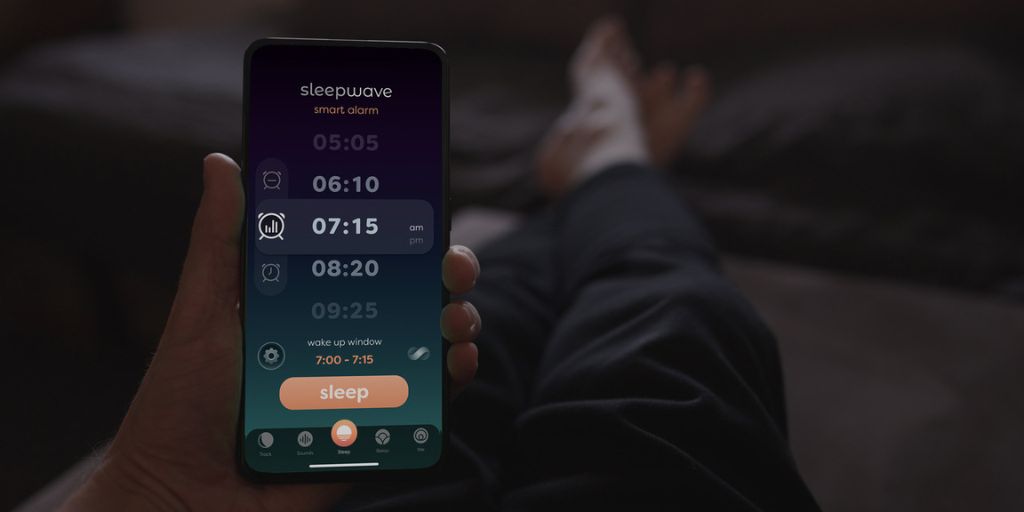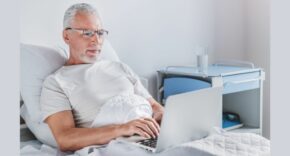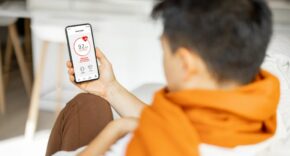
In today’s digitally connected world, smartphones offer an unexpected opportunity to address global sleep issues. Dr Tom Chambers, Clinical Advisor at Sleepwave, explores the growing need to improve sleep health, highlighting the impact poor sleep has on physical and mental well-being as well as its impact on the economy. This article examines widespread challenges such as the lack of awareness about the importance of good sleep health and the prevalence of insomnia and other sleep conditions.
Amid these challenges, solutions must be scalable and appropriate, with smartphones potentially playing a pivotal role. Once considered the villain in the context of sleep disruption, smartphones now have the chance to be heroes by providing convenient and effective tools for improving sleep.
Ultimately, this piece underscores the potential of smartphone technology in promoting global sleep health, offering a glimpse into a future where people worldwide can access tools to sleep better and lead healthier lives.
Sleep Health: A global problem
Sleep has long been an underappreciated pillar of health. Diet and exercise have been the subject of years of health advice, at times to the detriment of good sleep, for example when early morning or late-night work-outs take away from time spent sleeping (1). The essential role sleep plays in our physical health and mental wellbeing is being increasingly recognised (2). Anecdotally, we all know the benefits of a good night’s sleep. The old adages of ‘sleeping on a problem’ and ‘waking up on the wrong side of the bed’ highlight our intuitive knowledge that a good night’s sleep is vital to start our day well. Years of research have begun to uncover some of the many functions sleep plays in health including: immunity, metabolism, toxin clearance, memory consolidation and much, much more (3).
Sadly, the demands of modern society have relegated sleep to a secondary concern, with widespread consequences. Some estimates suggest average sleep time has dropped from 8 hours in the 1950s to just 6.5 hours in the mid 2010s (4). Inadequate sleep negatively impacts mood and cognition, and increases the risk of Alzheimers, cardiovascular disease, and cancer (5–7). There are financial consequences, too. The cost of inadequate sleep in Australia in 2016-17 was estimated at $66.3 billion.
Inadequate sleep is one thing, but sleep disorders too are frighteningly common and underdiagnosed. Insomnia impacts up to 1/3rd of people (8). A recent UK study found 29% of individuals suffered with insomnia symptoms but just 6% ever received a formal diagnosis (9). The figures for obstructive sleep apnoea (OSA), a disorder characterised by snoring and pauses in breathing during sleep, are even more stark. Approximately 1 billion people worldwide suffer from OSA (10). Up to 85% of these individuals are yet to be diagnosed (11). The health service costs of someone with undiagnosed sleep apnoea are up to 3x more than someone with identified and treated disease (12).
Fortunately, the needle is moving on working to improve sleep health. However, there is a great deal more to be done to understand the extent of global sleep issues and ultimately provide solutions. Just 22% of WHO member states have any published population-level sleep duration data (2). The global poor sleep epidemic is felt worse by those from lower socioeconomic groups, with higher rates of inadequate sleep, insomnia, and sleep apnoea (13)
There has been a technology boom in the sleep health space in recent years. Much of this has come in the form of hardware, with countless sleep trackers, smart watches, wearables and nearables available to record sleep. Sadly, this hardware will only widen health inequality as these costly devices are only available to a select few. Smartphones, owned by more than half of the world’s population (14), and used by over 90% of UK adults (15), could democratise access to novel sleep technology through innovations in software.
Smartphones and sleep: a tainted past
Smartphones have a reputation for damaging mental health, particularly in adolescents (16), and generally being bad news when it comes to sleep (17). Like most things in life, the reality is a little more complex (18). While the perils of smartphone overuse are widely known, they can be a force for good, with many dedicated mental health mobile apps demonstrating treatment success in a world where accessing professional mental health services is increasingly challenging (19).
Regarding sleep, classic thinking is that smartphone use reduces sleep time, results in worse sleep, and blue-light from screens causes circadian rhythm disruption, further disrupting sleep. Obviously, reading stressful emails or watching a horror movie just before, or instead of, sleeping is unwise and can cause the brain to feel overstimulated. The blue light picture is not so clear cut but it seems that protracted (5hr+) exposure to blue light is problematic, with little evidence regarding short-term exposure around bed time (18,20–22). Sleep is a highly personal experience and we are all likely to be impacted in different ways by our individual bedtime routines.
The future may hold promise in leveraging smartphone technology for good rather than evil when it comes to sleep. One growing area of interest is sleep tracking. Much of this comes from the wearable space but there are a number of smartphone-based trackers available. This area is one that needs some caution. Many trackers are unvalidated and make unsubstantiated claims regarding accuracy (23). A troubling phenomenon of ‘Orthosomnia’ has also developed in recent years (24). Orthosomnia describes the negative impact on sleep caused by trying to achieve ‘perfect’ sleep based on, often inaccurate (23,25,26), ‘sleep scores’ from their chosen tracker. This can be particularly problematic, particularly for those suffering from insomnia where we know that negative feedback about sleep perpetuates more sleep issues (27). Avoidance of a ‘sleep score’, and instead demonstrating sleep patterns over a period of time, is a better option for sleep trackers.
Smartphones and sleep: an optimistic future?
Whilst we need to be aware of the risks of smartphone usage and poor sleep, they may help to improve knowledge of global sleep patterns, can improve sleep disorders such as insomnia and snoring, and possibly could be used as an advanced screening tool for OSA.
One obvious smartphone use case is for sleep tracking to understand global sleep patterns, a necessity to first contextualise the problem of global sleep health to ultimately find solutions (2). Although consumer sleep technology (CST) struggles for accuracy in granular sleep staging, research suggests that CST accurately estimates total sleep time (26), and smartphone-based sleep tracking is becoming more reliable for measuring sleep duration (25). It’s in this context that promising apps like Sleepwave have created next-generation smartphone sleep tracking capabilities, with their patented technology able to track users’ movements and breathing from a phone beside their bed.
By leveraging its breakthrough technology, Sleepwave also provides users with a motion-sensing smart alarm. This feature detects movement to wake users up in lighter sleep stages, providing a more pleasant wake experience and helping to combat sleep inertia. Other apps like Sleepio and SnoreLab help individuals find solutions to their sleep problems. Sleepio, an evidence-backed (28,29) cognitive behavioural therapy for insomnia app (30), is free on the NHS to anyone in the UK, facilitating treatment for the millions of individuals suffering with insomnia. SnoreLab is the number 1 iOS and Android app for recording and measuring snoring and has been shown to accurately detect snoring compared to clinical standard respiratory polygraphy (31). To date, SnoreLab has garnered over 14 million downloads, helping countless people understand their snoring and discover solutions to improve it.
Finally, smartphones could play a role in diagnosis of sleep disorders, particularly in the case of OSA. With a billion people worldwide suffering with OSA (10), and around 800 million of these individuals currently undiagnosed (32), novel approaches to diagnostics that move away from costly and cumbersome polysomnography are a necessity. Smartphone-based ‘airable’ diagnostic technology is a growing area of interest (33,34). If these technologies are indeed shown to be accurate, they could genuinely revolutionise our approach to the global challenge of undiagnosed OSA.
Conclusions:
Sleep health is rightfully becoming a focus of global public health campaigns. Solutions to the many problems in this area require scalable, equitable solutions that are available to all. Where smartphones were once seen as the enemy here, they may well hold the key to understanding and improving our sleep on a global scale.
- Dubinina E, Korostovtseva LS, Rotar O, Amelina V, Boyarinova M, Bochkarev M, et al. Physical Activity Is Associated With Sleep Quality: Results of the ESSE-RF Epidemiological Study. Front Psychol. 2021 Aug 5;12:705212.
- Lim DC, Najafi A, Afifi L, Bassetti CLA, Buysse DJ, Han F, et al. The need to promote sleep health in public health agendas across the globe. Lancet Public Health. 2023 Oct;8(10):e820–6.
- Krueger JM, Frank MG, Wisor JP, Roy S. Sleep function: Toward elucidating an enigma. Sleep Med Rev. 2016 Aug;28:46–54.
- Foster R. Why do we sleep? [Internet]. TED Talk; 2013 Aug 14. Available from: https://www.youtube.com/watch?v=LWULB9Aoopc
- Medic G, Wille M, Hemels ME. Short- and long-term health consequences of sleep disruption. Nat Sci Sleep. 2017 May 19;9:151–61.
- Huang SY, Li YZ, Zhang YR, Huang YY, Wu BS, Zhang W, et al. Sleep, physical activity, sedentary behavior, and risk of incident dementia: a prospective cohort study of 431,924 UK Biobank participants. Mol Psychiatry. 2022 Oct;27(10):4343–54.
- Bishir M, Bhat A, Essa MM, Ekpo O, Ihunwo AO, Veeraraghavan VP, et al. Sleep Deprivation and Neurological Disorders. Biomed Res Int. 2020 Nov 23;2020:5764017.
- AASM. International Classification of Sleep Disorders (ICSD-3-TR). Darien, IL: American Academy of Sleep Medicine; 2023. (3rd ed, text revision).
- de Lange MA, Richmond RC, Eastwood SV, Davies NM. Insomnia symptom prevalence in England: a comparison of cross-sectional self-reported data and primary care records in the UK Biobank. BMJ Open. 2024 May 7;14(5):e080479.
- Benjafield AV, Ayas NT, Eastwood PR, Heinzer R, Ip MSM, Morrell MJ, et al. Estimation of the global prevalence and burden of obstructive sleep apnoea: a literature-based analysis. Lancet Respir Med. 2019 Aug;7(8):687–98.
- NICE Diagnostics Advisory Committee. Novel home-testing devices for diagnosing obstructive sleep apnoea/hypopnoea syndrome. NICE; 2024 Apr.
- Frost & Sullivan. Hidden Health Crisis Costing America Billions: Underdiagnosied and Undertreating Obstructive Sleep Apnea Draining Healthcare System. American Academy of Sleep Medicine; 2016.
- Billings ME, Cohen RT, Baldwin CM, Johnson DA, Palen BN, Parthasarathy S, et al. Disparities in Sleep Health and Potential Intervention Models: A Focused Review. Chest. 2021 Mar;159(3):1232–40.
- Global System for Mobile Communications. The State of Mobile Internet Connectivity Report 2023. GSM; 2023 Oct.
- Baker N. uswitch.com. 2024 [cited 2024 Apr 23]. UK mobile phone statistics, 2023. Available from: https://www.uswitch.com/mobiles/studies/mobile-statistics/
- Khalaf AM, Alubied AA, Khalaf AM, Rifaey AA. The Impact of Social Media on the Mental Health of Adolescents and Young Adults: A Systematic Review. Cureus. 2023 Aug;15(8):e42990.
- Touitou Y, Touitou D, Reinberg A. Disruption of adolescents’ circadian clock: The vicious circle of media use, exposure to light at night, sleep loss and risk behaviors. Journal of Physiology-Paris. 2016 Nov 1;110(4, Part B):467–79.
- Bauducco S, Pillion M, Bartel K, Reynolds C, Kahn M, Gradisar M. A bidirectional model of sleep and technology use: A theoretical review of How much, for whom, and which mechanisms. Sleep Med Rev. 2024 Aug;76:101933.
- Guracho YD, Thomas SJ, Win KT. Smartphone application use patterns for mental health disorders: A systematic literature review and meta-analysis. Int J Med Inform. 2023 Nov;179:105217.
- Chang AM, Aeschbach D, Duffy JF, Czeisler CA. Evening use of light-emitting eReaders negatively affects sleep, circadian timing, and next-morning alertness. Proc Natl Acad Sci U S A. 2015 Jan 27;112(4):1232–7.
- Foster R. Life Time: The New Science of the Body Clock, and How It Can Revolutionize Your Sleep and Health. Penguin UK; 2022. 480 p.
- Cajochen C, Frey S, Anders D, Späti J, Bues M, Pross A, et al. Evening exposure to a light-emitting diodes (LED)-backlit computer screen affects circadian physiology and cognitive performance. J Appl Physiol. 2011 May;110(5):1432–8.
- Russo K, Goparaju B, Bianchi MT. Consumer sleep monitors: is there a baby in the bathwater? Nat Sci Sleep. 2015 Nov 5;7:147–57.
- Baron KG, Abbott S, Jao N, Manalo N, Mullen R. Orthosomnia: Are Some Patients Taking the Quantified Self Too Far? J Clin Sleep Med. 2017 Feb 15;13(2):351–4.
- Fino E, Plazzi G, Filardi M, Marzocchi M, Pizza F, Vandi S, et al. (Not so) Smart sleep tracking through the phone: Findings from a polysomnography study testing the reliability of four sleep applications. J Sleep Res. 2020 Feb;29(1):e12935.
- Lee T, Cho Y, Cha KS, Jung J, Cho J, Kim H, et al. Accuracy of 11 Wearable, Nearable, and Airable Consumer Sleep Trackers: Prospective Multicenter Validation Study. JMIR Mhealth Uhealth. 2023 Nov 2;11:e50983.
- Gavriloff D, Sheaves B, Juss A, Espie CA, Miller CB, Kyle SD. Sham sleep feedback delivered via actigraphy biases daytime symptom reports in people with insomnia: Implications for insomnia disorder and wearable devices. J Sleep Res. 2018 Dec;27(6):e12726.
- Espie CA, Emsley R, Kyle SD, Gordon C, Drake CL, Siriwardena AN, et al. Effect of Digital Cognitive Behavioral Therapy for Insomnia on Health, Psychological Well-being, and Sleep-Related Quality of Life: A Randomized Clinical Trial. JAMA Psychiatry. 2019 Jan 1;76(1):21–30.
- Henry AL, Miller CB, Emsley R, Sheaves B, Freeman D, Luik AI, et al. Does treating insomnia with digital cognitive behavioural therapy (Sleepio) mediate improvements in anxiety for those with insomnia and comorbid anxiety? An analysis using individual participant data from two large randomised controlled trials. J Affect Disord. 2023 Oct 15;339:58–63.
- BigHealth. Big Health UK | Helping millions back to good mental health. 2024 [cited 2024 May 9]. Sleepio – CBT for insomnia – Big Health UK. Available from: https://www.bighealth.co.uk/sleepio/
- Klaus K, Stummer AL, Ruf S. Accuracy of a Smartphone Application Measuring Snoring in Adults-How Smart Is It Actually? Int J Environ Res Public Health [Internet]. 2021 Jul 8;18(14). Available from: http://dx.doi.org/10.3390/ijerph18147326
- Faria A, Allen AH, Fox N, Ayas N, Laher I. The public health burden of obstructive sleep apnea. Sleep Sci. 2021 Jul;14(3):257–65.
- Kim DH, Kim SW, Hwang SH. Diagnostic value of smartphone in obstructive sleep apnea syndrome: A systematic review and meta-analysis. PLoS One. 2022 May 19;17(5):e0268585.
- Le VL, Kim D, Cho E, Jang H, Reyes RD, Kim H, et al. Real-Time Detection of Sleep Apnea Based on Breathing Sounds and Prediction Reinforcement Using Home Noises: Algorithm Development and Validation. J Med Internet Res. 2023 Feb 22;25:e44818.












